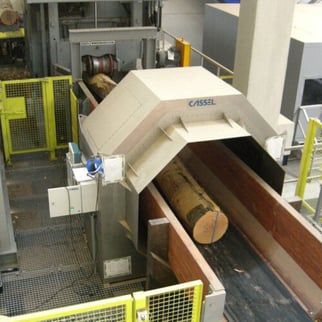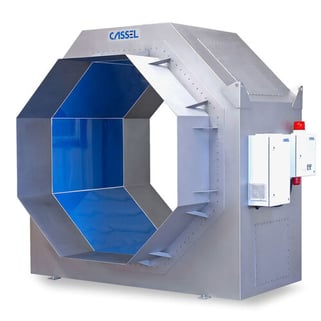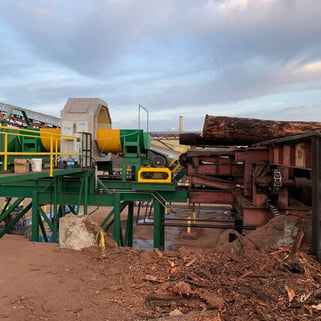Metal detector protects machines and reduces waste of valuable logs
Metal parts in wood always present the wood industry with an unpleasant choice: They can accept contamination by smaller metal parts, but risk damage to machines and sometimes long downtimes. Or you can play it safe and eliminate everything that contains metal from production. This can then also affect valuable tree trunks that could actually be processed.
The dilemma: Machine or material?
 Many metal detectors cannot find similar sized metal pieces in all areas of the trunk. Most detectors detect metal contaminants on the outer edge of a tree trunk better than metal that lies deep in the wood.
Many metal detectors cannot find similar sized metal pieces in all areas of the trunk. Most detectors detect metal contaminants on the outer edge of a tree trunk better than metal that lies deep in the wood.
If such a detector is adjusted very sensitive, e.g. to find shrapnel that has drilled deep into the wood, it will also find tiny nails in the outer part of the trunk, which are no danger for the saw or the knife. He also reports “metal” on the tiny nails and valuable logs are discarded, which could actually be processed.
If the same metal detector is set to not find these tiny nails, it will not find larger pieces of metal inside the log that could cause damage.
The result is an unpleasant balancing act: Either you protect your machines and discard valuable logs, or you risk machine damage and long downtime.
Expensive downtime
 Metal contamination in wood can be very costly. In addition to the damage to saws and rollers, there are costs for downtimes: “One hour of downtime costs around 5,000 euros,” explained the technical manager of a large German chipboard factory. Repairing large saws or rollers for chipboard can take days in the worst case – an expensive undertaking.
Metal contamination in wood can be very costly. In addition to the damage to saws and rollers, there are costs for downtimes: “One hour of downtime costs around 5,000 euros,” explained the technical manager of a large German chipboard factory. Repairing large saws or rollers for chipboard can take days in the worst case – an expensive undertaking.
But metal contamination is also more expensive if it does not lead to a machine standstill. Even if the saws can still work their way through nails or other metal parts, the metal will still clog the blades. The costs for re-sharpening increase noticeably.
Better metal detection even deep in the trunk
The METAL SHARK® OCTA offers significant advantages over many other metal detectors for this problem. Several overlapping magnetic fields are generated within the octagonal shape, the measuring field is ten times stronger than that of conventional metal detectors of this size. This overlap enhances the detection performance of the OCTA exactly where it normally weakens – inside the tree trunk. Thus, it detects similarly large metal parts inside and outside the trunk. The strong magnetic field significantly reduces interference (disturbance of the magnetic field) from other machines, resulting in more reliable measurements.
If the device is set to detect shrapnel above a certain size, the OCTA will find shrapnel deep inside the trunk or on its surface. Small nails on the other hand are not detected. In this way, only those logs are sorted out that actually pose a danger to the machines.
Significant savings
 The basic problem remains, of course: wood that is contaminated with large metal parts must be sorted out before it enters the machines. This costs valuable material. Nevertheless, these costs can be significantly reduced by using a well-adjusted metal detector that is adapted to the special requirements of the wood industry.
The basic problem remains, of course: wood that is contaminated with large metal parts must be sorted out before it enters the machines. This costs valuable material. Nevertheless, these costs can be significantly reduced by using a well-adjusted metal detector that is adapted to the special requirements of the wood industry.
Some metal parts are so small that they do not harm the machines and do not disturb the further processing. The more precisely the limit size of these metal parts is known, the better material rejects can be avoided. And the more precisely the detector can detect metal inside and outside, the better it can be adjusted to this limit size.
Our customer from the chipboard and OSB production knows the advantage of the OCTA and comes to a clear conclusion: “We cannot run our OSB production line without the CASSEL METAL SHARK® at all.